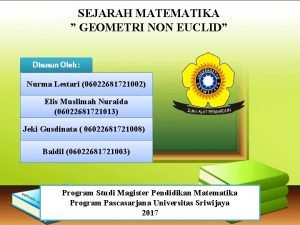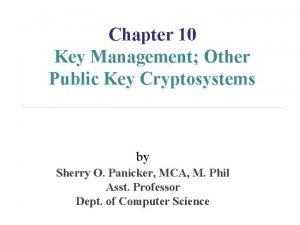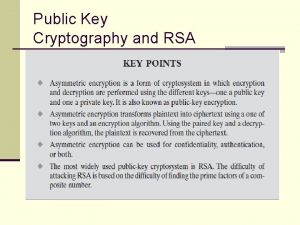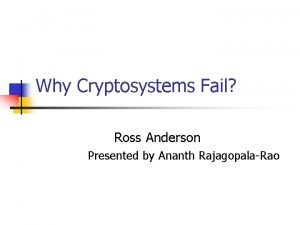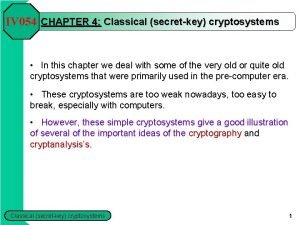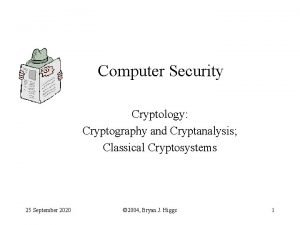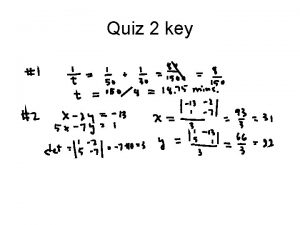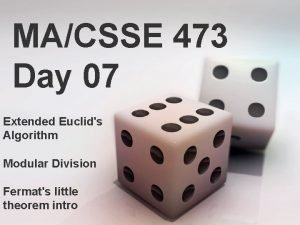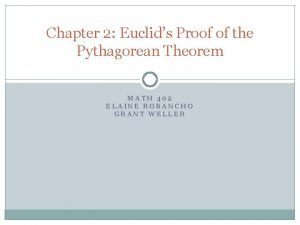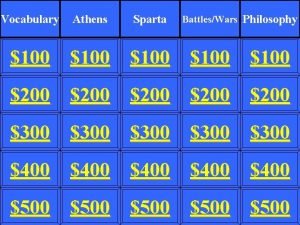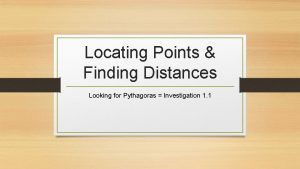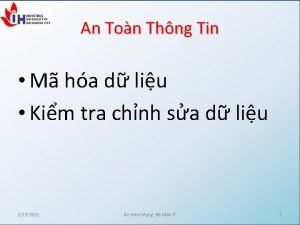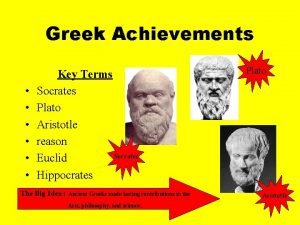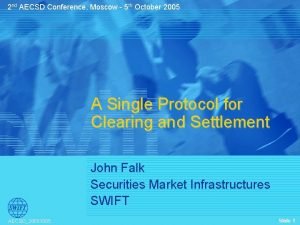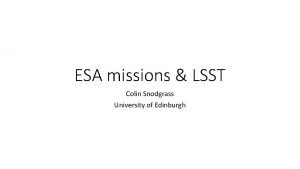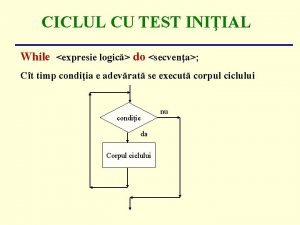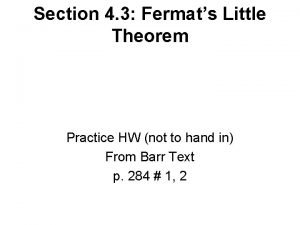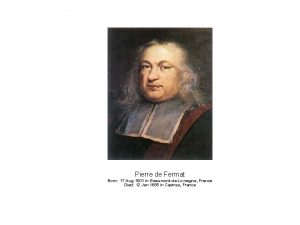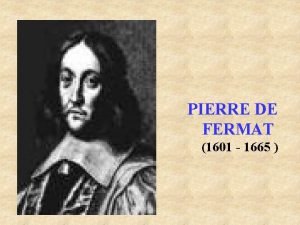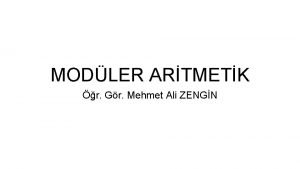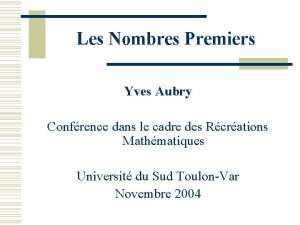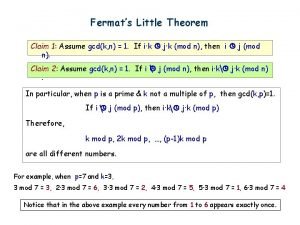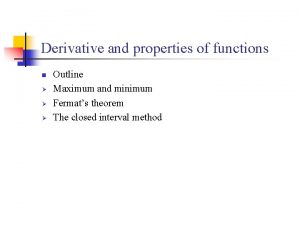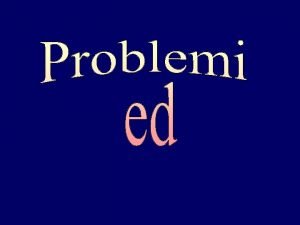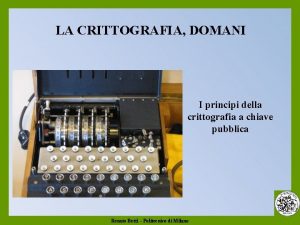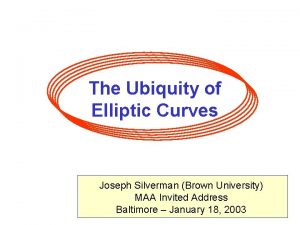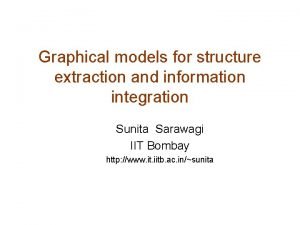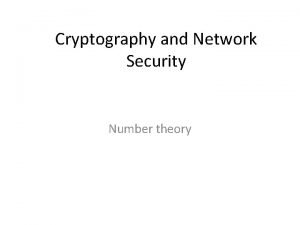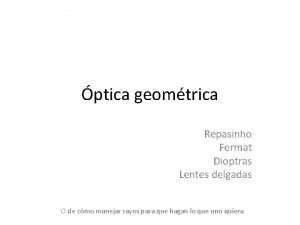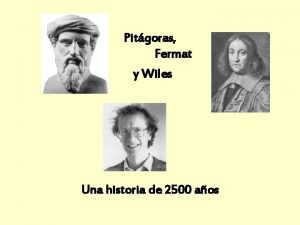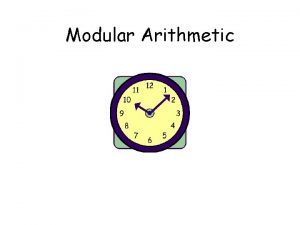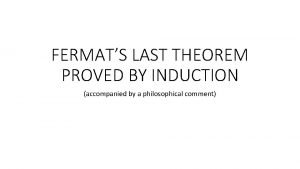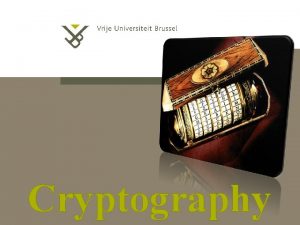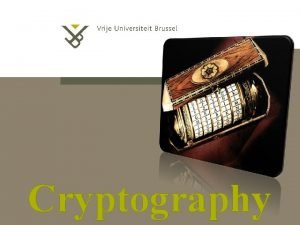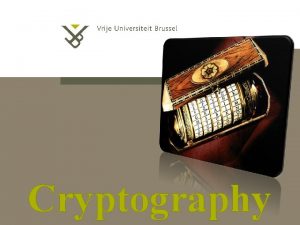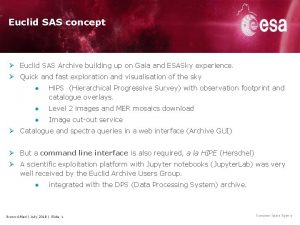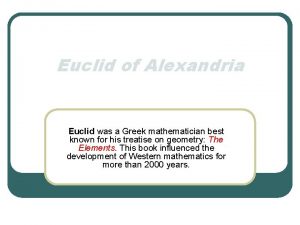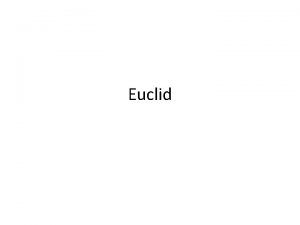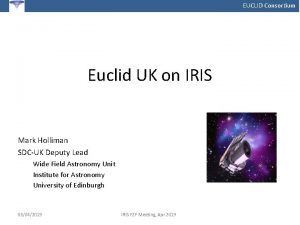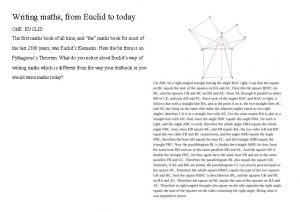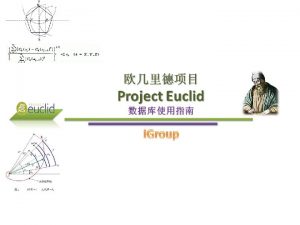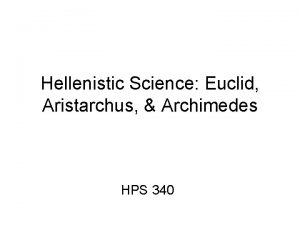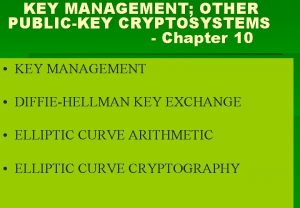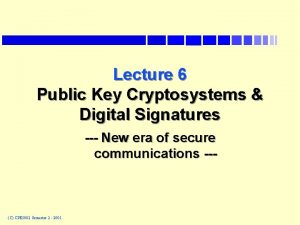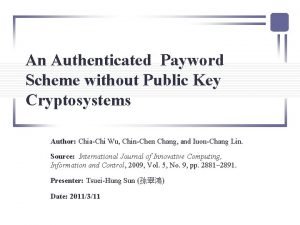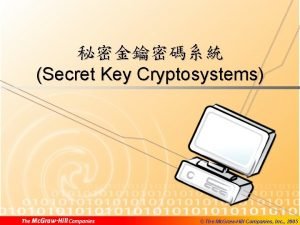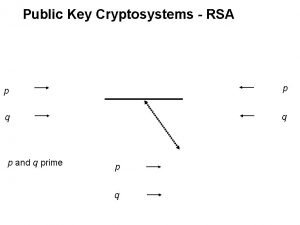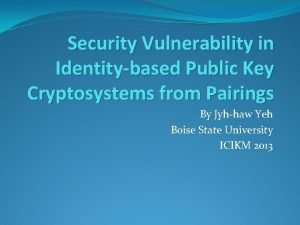Lecture 8 Nonsecret Key Cryptosystems How Euclid Fermat












































- Slides: 44

Lecture 8: Non-secret Key Cryptosystems (How Euclid, Fermat and Euler Created E-Commerce) Real mathematics has no effects on war. No one has yet discovered any warlike purpose to be served by theory of numbers. G. H. Hardy, The Mathematician’s Apology, 1940. CS 588: Security and Privacy David Evans University of Virginia 24 Sept 2001 University of Virginia CS 588 http: //www. cs. virginia. edu/~evans Computer Science

Public-Key Applications: Privacy Bob Alice Plaintext Encrypt Ciphertext Bob’s Public Key Decrypt Plaintext Bob’s Private Key • Alice encrypts message to Bob using Bob’s Private Key • Only Bob knows Bob’s Private Key only Bob can decrypt message 24 Sept 2001 University of Virginia CS 588 2

Signatures Alice Plaintext Encrypt Signed Message Alice’s Private Key Decrypt Bob Plaintext Alice’s Public Key • Bob knows it was from Alice, since only Alice knows Alice’s Private Key • Non-repudiation: Alice can’t deny signing message (except by claiming her key was stolen!) • Integrity: Bob can’t change message (doesn’t know Alice’s Private Key) 24 Sept 2001 University of Virginia CS 588 3

Public-Key Cryptography • • • Private procedure: E Public procedure: D Identity: E (D (m)) = D (E (m)) = m Secure: cannot determine E from D But didn’t know how to find suitable E and D 24 Sept 2001 University of Virginia CS 588 4

Properties of E and D Trap-door one way function: 1. D (E (M)) = M 2. E and D are easy to compute. 3. Revealing E doesn’t reveal an easy way to compute D Trap-door one way permutation: also 4. E (D (M)) = M 24 Sept 2001 University of Virginia CS 588 5

RSA E(M) = Me mod n D(C) = Cd mod n (red = secret) n = pq p, q are prime d is relatively prime to (p – 1)(q – 1) ed 1 (mod (p – 1)(q – 1)) 24 Sept 2001 University of Virginia CS 588 6

RSA in Perl print pack"C*", split/D+/, `echo Until"16 i. II*oU@{$/=$z; 1997 – Illegal [(pop, unpack"H*", <>)]} to show this slide to Es. Ms. Ks. N 0[l. N*1 l. K[d 2%Sa 2/d 0 <X+d*l. MLa^*l. N%0]ds. Xx++l. Ml. N non-US citizens! /ds. M 0<J]ds. Jxp"|dc` (by Adam Back) Until Jan 2000: can export RSA, but only with 512 bit keys Now: can export RSA except to embargoed destinations 24 Sept 2001 University of Virginia CS 588 7

First Amendment Because computer source code is an expressive means for the exchange of information and ideas about computer programming, we hold that it is protected by the First Amendment. Sixth Circuit Court of Appeals, April 4, 2000 Ruling that Peter Junger could post RSA source code on his web site 24 Sept 2001 University of Virginia CS 588 8

Properties of E and D Trap-door one way function: 1. D (E (M)) = M 2. E and D are easy to compute. 3. Revealing E doesn’t reveal an easy way to compute D Trap-door one way permutation: also 4. E (D (M)) = M 24 Sept 2001 University of Virginia CS 588 9

Property 1: D (E (M)) = M E(M) = Me mod n D(E(M)) = (Me mod n)d mod n = Med mod n (as in D-H proof) Can we choose e, d and n so: M Med mod n 1 Med-1 mod n 24 Sept 2001 University of Virginia CS 588 10

Euler’s totient (phi) function • (n) = number of positive integers < n which are relatively prime to n. • If n is prime, (n) = n – 1. – Proof by contradiction. 24 Sept 2001 University of Virginia CS 588 11

Totient Products For primes, p and q: n = pq (n) = (pq) (n) = numbers < n not relatively prime to pq = pq – 1 numbers less than pq – p, 2 p, 3 p, …, (q – 1)p ; q-1 of them – q, 2 q, 3 q, …, (p – 1)q ; p-1 of them = pq – 1 – (q – 1) – (p – 1) = pq – (p + q) + 1 = (p – 1) (q – 1) = (p) (q) 24 Sept 2001 University of Virginia CS 588 12

Euler’s Theorem • For a and n relatively prime: a (n) 1 mod n • Recall: we are looking for e, d and n such that: Med-1 1 mod n 24 Sept 2001 University of Virginia CS 588 13

Fermat’s Little Theorem If n is prime and a is not divisible by n an-1 1 mod n Stronger version: (in MBC p. 200): If n is prime, for any a: an a mod n 24 Sept 2001 University of Virginia CS 588 14

Fermat’s Little Theorem Proof {a mod n, 2 a mod n, … , (n-1)a mod n} = {1, 2, …, (n – 1) } if ab mod n = ac mod n and a is relatively prime to n then b = c mod n 24 Sept 2001 University of Virginia CS 588 15

Fermat’s Little Theorem Proof {a mod n, 2 a mod n, … , (n-1)a mod n} = {1, 2, …, (n – 1) } a 2 a … (n – 1) a (n – 1)! mod n (n – 1)!an-1 (n – 1)! mod n an-1 1 mod n 24 Sept 2001 University of Virginia CS 588 16

Euler’s Theorem For a and n relatively prime: a (n) 1 mod n Proof: If n is prime, (n) = n – 1 and an - 1 1 mod n by Fermat’s Little Theorem. What if n is not prime? 24 Sept 2001 University of Virginia CS 588 17

Euler’s Theorem, cont. For a and n relatively prime: a (n) 1 mod n (n) = number of numbers < n not relatively prime to n We can write those numbers as: R = { x 1, x 2, … , x (n)} 24 Sept 2001 University of Virginia CS 588 18

Proving Euler’s Theorem R = { x 1, x 2, … , x (n)} multiply by a mod n: S = { ax 1 mod n, ax 2 mod n, …, ax (n) mod n} S is a permutation of R: – a is relatively prime to n and xi so axi is relatively prime to n hence all elements of S are in R. – There are no duplicates in S. If axi mod n = axj mod n then i = j. since a is relatively prime to n. 24 Sept 2001 University of Virginia CS 588 19

Proving Euler’s Theorem x 1 x 2 … x (n) = ax 1 mod n ax 2 mod n … ax (n) mod n (ax 1 ax 2 … ax (n)) mod n a (n) x 1 x 2 … x (n) mod n 1 a (n) mod n 24 Sept 2001 University of Virginia CS 588 QED. 20

Recap • Euler’s Theorem: 1 a (n) mod n if M is not for a and n relatively prime What relatively prime to n? • If n is prime, (n) = n – 1. • For p and q prime, (pq) = (p) (q) • We are looking for e, d and n such that: Med-1 1 mod n ed – 1 = (n) = (p-1)(q-1) 24 Sept 2001 University of Virginia CS 588 21

M and n • Suppose M and n not relatively prime: gcd (M, n) 1 • Since n = pq and p and q are prime: gcd (M, p) 1 OR gcd (M, q) 1 Case 1: M = cp gcd (M, q) = 1 (otherwise M is multiple of both p and q, but M < pq). So, M (q) 1 mod q (by Euler’s theorem, since M and q are relatively prime) 24 Sept 2001 University of Virginia CS 588 22

M and n, cont Case 1: M = cp gcd (M, q) = 1 (otherwise M is multiple of both p and q, but M < pq). So, M (q) 1 mod q (by Euler’s theorem, since M and q are relatively prime) M (q) 1 mod q (M (q)) (p) 1 mod q M (q) (p) 1 mod q M (n) 1 mod q 24 Sept 2001 University of Virginia CS 588 23

M and n M (n) 1 mod q M (n) = 1 + kq for some k M = cp recall gcd (M, p) 1 M M (n) = (1 + kq)cp M (n) + 1 = cp + kqcp = M + kcn M (n) + 1 M mod n 24 Sept 2001 University of Virginia CS 588 24

Where’s ED? ed – 1 = (n) = (p-1)(q-1) • So, we need to choose e and d: • ed = (n) + 1 = n – (p + q) Pick random d, relatively prime to (n) gcd (d, (n)) = 1 • Since d is relatively prime to (n) it has a multiplicative inverse e: de 24 Sept 2001 1 mod (n) University of Virginia CS 588 25

Identity de 1 mod (n) So, d * e = (k * (n)) + 1 for some k. Hence, Med-1 mod 24 Sept 2001 n= (n) k * M mod University of Virginia CS 588 n 26

D (E (M)) = M Med-1 mod n = Mk * (n) mod n Euler says 1 M (n) mod n. So 1 Mk * (n) mod n 1 Med-1 mod n M Med mod n QED. 24 Sept 2001 University of Virginia CS 588 27

Properties of E and D Trap-door one way function: 1. D (E (M)) = M 2. E and D are easy to compute. 3. Revealing E doesn’t reveal an easy way to compute D Trap-door one way permutation: also 4. E (D (M)) = M 24 Sept 2001 University of Virginia CS 588 28

Property 2: Easy to Compute • E(M) = Me mod n • Easy – every 4 th grader can to exponents, every kindergartner can do mod n. • How big are M, e, and n? – M: 2 n where n is the number of bits in M – M and n must be big (~10200) for security 24 Sept 2001 University of Virginia CS 588 29

Fast Exponentiation • am + n = a m * an • ab = ab/2 * ab/2 (if 2 divides b) • So, can compute Me in about log 2 e multiplies • 10150 < 2512, 512 multiplies is doable (by a computer, not a kindergartner) • Faster bitwise algorithms known 24 Sept 2001 University of Virginia CS 588 30

Anything else hard to compute? • We need to find large prime numbers p and q • Obvious way: Pick big number x for i = 2 to sqrt x - 1(x) if i divides x its not prime, start over with x + 1 done – x is prime 24 Sept 2001 University of Virginia CS 588 31

How many prime numbers? • Infinite (proved by Euclid, 300 BC) • Proof by contradiction: Suppose that there exist only finitely many primes p 1 < p 2 <. . . < pr. Let N = (p 1)(p 2). . . (pr) + 1 N > pr so it is composite, N = p * M If p = pi for some 1…r, then, N = pi * M = pi * (p 1)(p 2). . . (pi-1) (pi+1). . . (pr) + 1 pi (M - (p 1)(p 2). . . (pi-1) (pi+1). . . (pr)) = 1 Contradiction: pi > 1 Hence, there must be infinitely many primes. 24 Sept 2001 University of Virginia CS 588 32

Density of Primes (x) is the number of primes x From http: //www. utm. edu/research/primes/howmany. shtml 24 Sept 2001 University of Virginia CS 588 33

Approximating (x) • The Prime Number Theorem: (x) ~ x/ln x • So, to find a prime bigger than x, we need to make about ln x/2 guesses • (Naïvely) Each guess requires sqrt(x) work • For 200 digits (worst imaginable case): 230 guesses * 10100 • More work than breaking 3 DES! 24 Sept 2001 University of Virginia CS 588 34

Need a faster prime test • There are several fast probabilistic prime tests • Can quickly test a prime with high probability, with a small amount of work • If we pick a non-prime, its not a disaster (exercise for reader, will be on PS 3) 24 Sept 2001 University of Virginia CS 588 35

Fermat Test • Recall Fermat’s Little Theorem: if n is prime and a is not divisible by n then an-1 1 mod n • Prove n is composite by finding an-1 1 mod n • Showing an-1 1 mod n does not prove it is prime • But if it holds for many a’s it is likely than n is prime – Holds for all a’s for some non-primes known as Carmichael Numbers: 561, 645, 1105, …) 24 Sept 2001 University of Virginia CS 588 36

Properties of E and D Trap-door one way function: 1. D (E (M)) = M 2. E and D are easy to compute. 3. Revealing E doesn’t reveal an easy way to compute D Trap-door one way permutation: also 4. E (D (M)) = M 24 Sept 2001 University of Virginia CS 588 37

Property 4: E (D (M)) = M D(M) = Md mod n E(D(M)) = (Md mod n)e mod n = Mde mod n = Med mod n = M (from the property 1 proof) 24 Sept 2001 University of Virginia CS 588 38

Applications of RSA • Privacy: – Bob encrypts message to Alice using EA – Only Alice knows DA • Signatures: – Alice encrypts a message to Alice using DA – Bob decrypts using EA – Knows it was from Alice, since only Alice knows DA • Things you use every day: ssh, SSL, DNS, etc. 24 Sept 2001 University of Virginia CS 588 39

Two “Questionable” Statements in RSA Paper 1. “The need for a courier between every pair of users has thus been replaced by the requirement for a single secure meeting between each user and the public file manager when the user joins the system. ” (p. 6) 24 Sept 2001 University of Virginia CS 588 40

Two “Questionable” Statements in RSA Paper 2. “(The NBS scheme (DES) is probably somewhat faster if special-purposed hardware encryption devices are used; our scheme may be faster on a general -purpose computer since multiprecision arithmetic operations are simpler to implement than complicated bit manipulations. )” (p. 4) 24 Sept 2001 University of Virginia CS 588 41

Who really invented RSA? • General Communications Headquarters, Cheltenham (formed from Bletchley Park after WWII) • 1969 – James Ellis asked to work on key distribution problem • Secure telephone conversations by adding “noise” to line • Late 1969 – idea for PK, but function 24 Sept 2001 University of Virginia CS 588 42

RSA & Diffie-Hellman • Asks Clifford Cocks, Cambridge mathematics graduate, for help • He discovers RSA (four years early) • Then (with Malcolm Williamson) discovered Diffie-Hellman • Kept secret until 1997! • NSA claims they had it even earlier 24 Sept 2001 University of Virginia CS 588 43

Charge • • • Reread the parts of RSA paper you didn’t understand the first time PS 2 Due Weds Next time: security of RSA (third property) 3. Revealing E doesn’t reveal an easy way to compute D 24 Sept 2001 University of Virginia CS 588 44
 Geometri euclid dan non euclid
Geometri euclid dan non euclid Nonsecret
Nonsecret Chapter 10: other public-key cryptosystems
Chapter 10: other public-key cryptosystems Principles of public key cryptosystems
Principles of public key cryptosystems Why cryptosystems fail
Why cryptosystems fail Cryptosystem
Cryptosystem Cryptosystems
Cryptosystems Classical cryptosystems
Classical cryptosystems Why cryptosystems fail
Why cryptosystems fail Euclidean algorithm example
Euclidean algorithm example Euclid's algorithm
Euclid's algorithm Euclid's proof of the pythagorean theorem
Euclid's proof of the pythagorean theorem Pythagoras and euclid were outstanding hellenistic
Pythagoras and euclid were outstanding hellenistic Looking for pythagoras
Looking for pythagoras Euclid mở rộng
Euclid mở rộng Achievements of socrates
Achievements of socrates Euroclear euclid
Euroclear euclid Colin snodgrass
Colin snodgrass Cmmdc euclid
Cmmdc euclid 01:640:244 lecture notes - lecture 15: plat, idah, farad
01:640:244 lecture notes - lecture 15: plat, idah, farad Anna horak
Anna horak Exponents in modular arithmetic
Exponents in modular arithmetic Pierre de fermat family
Pierre de fermat family Pierre de fermat
Pierre de fermat Fermat teoremi
Fermat teoremi Crible d'eratosthène
Crible d'eratosthène Fermats little theorem
Fermats little theorem Fermat's theorem
Fermat's theorem 6 modulo 3
6 modulo 3 Teorena
Teorena Piccolo teorema di fermat
Piccolo teorema di fermat Prinsip fermat
Prinsip fermat Piccolo teorema di fermat
Piccolo teorema di fermat Piccolo teorema di fermat
Piccolo teorema di fermat Fermat's last theorem
Fermat's last theorem Fermat's last theorem
Fermat's last theorem Fermat's theorem in cryptography and network security
Fermat's theorem in cryptography and network security Théoreme de fermat
Théoreme de fermat Dioptras
Dioptras Fermat
Fermat Teorema de fermat
Teorema de fermat Modulo arithmetic rules
Modulo arithmetic rules Last theorem
Last theorem Key business activities
Key business activities Key partners
Key partners
